(February 4, 2025) He was just seven kilometers away from scripting history as the first Indian to ski solo and unsupported to the South Pole when Satish Gogineni could see Amundsen–Scott South Pole Station and a few explorers waiting for him at the finish line. But the 41-year-old adventurer didn’t want the journey, spanning across 51 days and 1133 km, to end. For the last fifty days, he had been braving unforgiving terrain and unpredictable weather to finish an expedition that no other Indian has done. Now, this close to his destination, he wanted to linger on the feeling for a little longer. “I’d get emotional almost every day thinking about the moment I’d raise the Indian flag at the South Pole,” Satish tells Global Indian. “The journey was beautiful and I didn’t want it to end.”
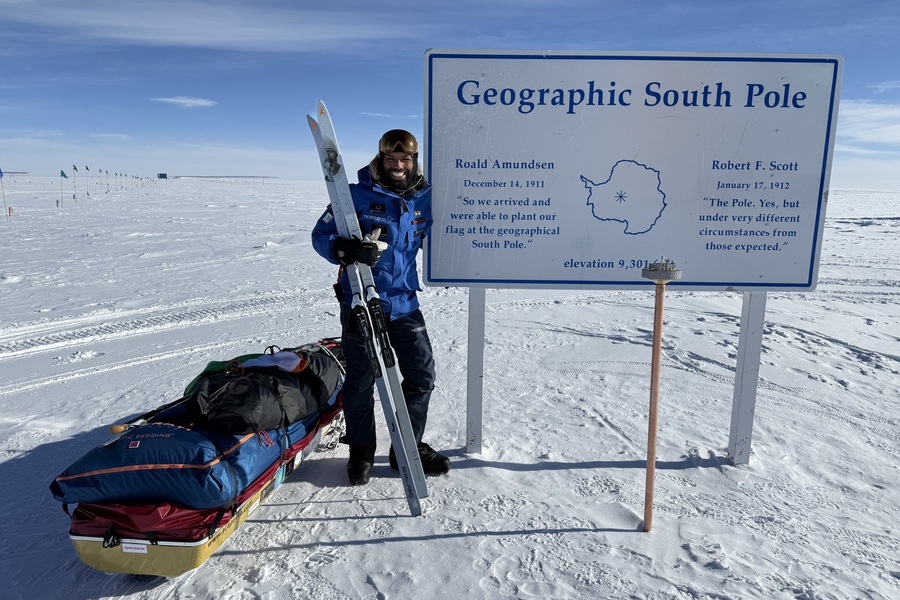
Satish Gogineni at the South Pole
Breaking Ice and Barriers: Why Representation Matters
But he picked up his skis and finished the last few kilometres to create history. Yet, this wasn’t the first time Satish has put India on the global map. In 2022, he became the fastest Indian to summit Mt Everest and Mt Lhotse in 18 hours. “I don’t look at it from the record perspective but from representation perspective,” says Satish, who moved to the US in 2004. “Representation matters and it’s important to me.”
When Satish started running marathons in the US about 15 years ago, he could hardly find someone who looked like him. “Initially, it was exciting to represent as a brown guy, but when I transitioned from marathons to mountaineering and hiking, I found myself in spaces where people questioned whether I even belonged. That’s when I realised the importance of representation. Standing at the South Pole feels the same because, historically, polar exploration has been dominated by Norwegians and the British. For me, it’s about shattering limits and redefining what Indians can achieve.”
Training for the Impossible: From Baffin Island to Greenland
It was in Baffin Island in Canada that Satish began training for his Polar expedition in March 2024. “It was the first time I wore the Nordic skis on me.” Coming from California’s warm climate to Canada’s freezing minus 24 degrees, Satish took time to adjust, since it gets humid in the Arctic. However, sweating isn’t an option as cold winds can easily turn it into frostbite. “It was my first time learning the tropes.”
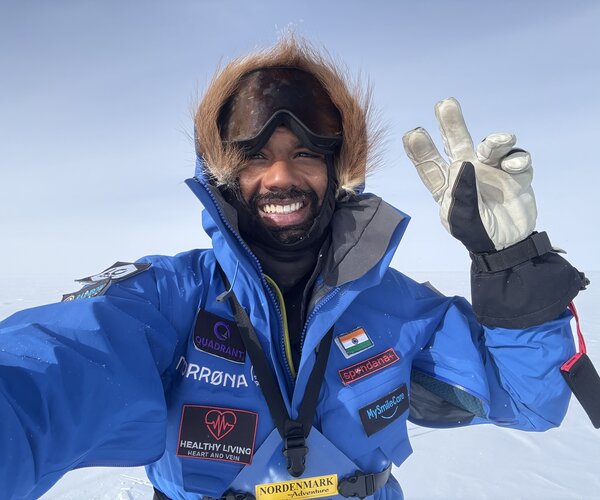
Even during training, no one believed Satish could embark on a Polar expedition since people train for years, while he aimed to do it in a few months. But he was committed and took off to Greenland for a four-week group expedition in May, however, he skipped the solo expedition – a dealbreaker for the Polar expedition. He doubted that the Antarctica Logistics Expedition (ALE) would approve of his Polar expedition. But after witnessing his performance during training in Greenland – Lars, who works for Polar legend Borge Ousland – stepped in to support him. “I applied in July and was accepted for a Polar expedition in August. I had two months to prepare and secure the funds before setting off in November.”
A Battle Against the Elements: 51 Days in Antarctica
With the least experience among his fellow expeditioners, his presence was often questioned. “Being the first Indian allowed to do this; I felt a deep responsibility — I couldn’t afford to disappoint.” With this, he began his 1133 km journey from Hercules Inlet on November 21. Despite training for months, Satish quickly understood that ground zero reality was very different, with terrain being the biggest challenge. For the first week, he could only ski for 11-12 km when he expected to cover 25-30 km daily. “Cold is an issue but so are whiteouts with almost no visibility. It feels like you are walking inside a marshmallow. Those days are frustrating as you often run into sastrugi, the wind formations, that can be 30-40 feet, making it difficult to find a way through. Snow conditions, visibility, and terrain all matter, each adding to the struggle. On some days, it’s mentally draining—you might cover only 7-8 km, spending 40 minutes just trying to navigate out of sastrugi with a 126 kg sled in tow.”
But with each passing day, he grew more familiar with Antarctica conditions, making navigation easier. “Initially, I’d be stuck in the sastrugi for longer, but over time, I realised that by pushing my sled back and moving 30 feet east or west, I could find a clear path forward. I also learned that during a whiteout, it’s important to ski straight. On sunny days, I’d practice skiing straight for my whiteout days or low visibility days,” adds Satish, who calls himself a problem solver. “I enjoy solving problems at work and even in a new environment as extreme as Antarctica”, says the man who quit his job as a VP at the Bank of America to embark on the Polar expedition.
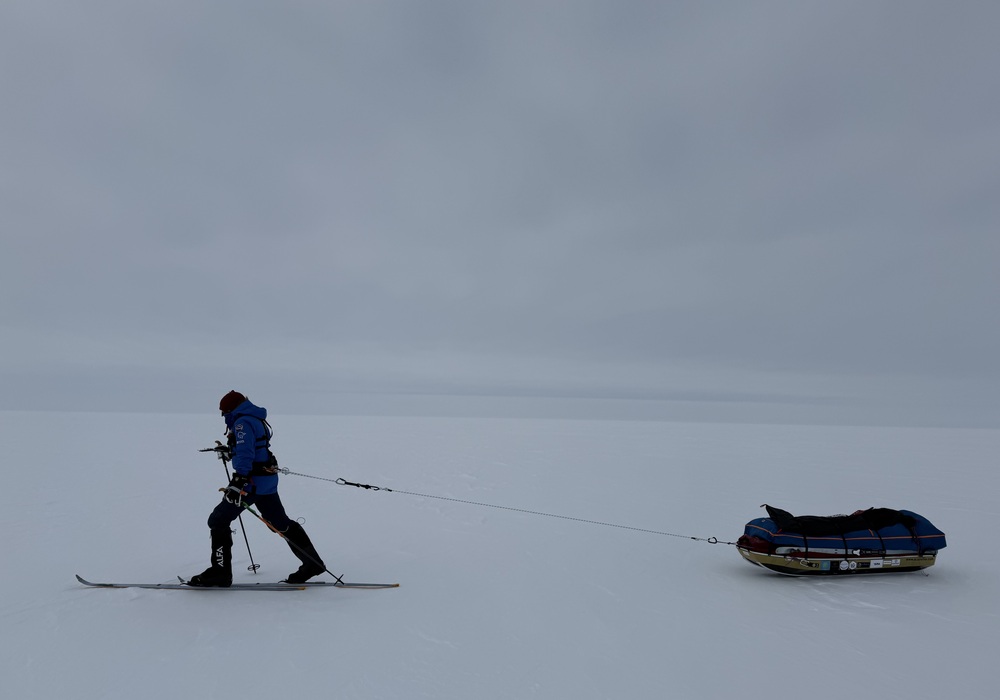
Apart from the tough terrain, Satish had to manage a 126 kg sled that carried food, a spare ski, a medicine kit, a daily kit, one extra pair of clothes, two stoves, two sets of poles, a sleeping system, a tent, 13 litres of gas for fuel, toilet paper, two manual compasses, two electronic GPS, two satellite phones and two sets of solar panels. “Each evening, I checked in with ALE to update on my day, any medical issues, and my location. If I went missing, they would have known my last position as they provided me a tracker too.”
The food itself weighed 84 kg as he prepared well enough for the next 51 days in the polar region. “For breakfast, I had cereal or muesli with chocolate. During the day, I snacked on nuts, gummies, and a bar of chocolate, along with biscuits, wafers, and dried fruits. Dinner consisted of freeze-dried meals or noodles, mixed with butter, cheese, or sausages. I consumed 6,000 calories daily but burned nearly 8,000, “says Satish, who weighed 91 kg at the start of the expedition and returned weighing 80 kg.
More Than an Expedition: Raising Awareness for Mental Health
Till now, only 52 people have been able to reach the South Pole solo and unsupported, and Satish is the first Indian to achieve the feat by braving intense temperatures of -37 degrees and skiing over 51 days. Despite the challenges and harsh conditions, he kept himself motivated knowing that he wasn’t just representing India, this was another opportunity to raise awareness on mental health and stay true to people like Vivek Mehra, Asha Jadeja Motwani, Rajesh Ramineni and Dheeraj Pamidimukkala who helped raise $120,000 for his expedition. “Though I was skiing alone, there were so many people behind me, and I owed it to them. The cause, the support system, and the chance to silence the naysayers were my motivation factors.”
View this post on Instagram
His efforts began in 2023 with Project Spandana, which was a tribute to his cousin Spandana who died by suicide. Earlier in 2011, he lost his mother to suicide. “I struggled to open up about my mom’s suicide, keeping it bottled up for years for fear of judgement. But after my cousin’s death, I realised I should have been more vocal as it could have helped my cousin seek help rather than taking the irreversible step,” says Satish, who himself battled mental health issues during the pandemic. After his cousin’s death, Satish made it his mission to advocate for mental health awareness, encouraging people to empower themselves and face their challenges head-on.
It was a dark time for Satish Gogineni when his mom committed suicide. While he was running physically tiring marathons, he couldn’t feel any pain. “I realised there is nothing more painful than to have dealt with my mom’s death. I have climbed many mountains and I think none of them was as physically or mentally difficult as dealing with the loss of my mother. Hence, I have made it my mission to create awareness on mental awareness with each of my summits or expeditions,” reveals Satish.
With each expedition, his goal is twofold – representation and mental health awareness. “Most see me as adventurous, the life of the party, but they don’t know about my struggles with anxiety, and depression, or that I once considered suicide. I need to share that side of my story — to show that it’s possible to overcome, heal, and live a fulfilling life.”
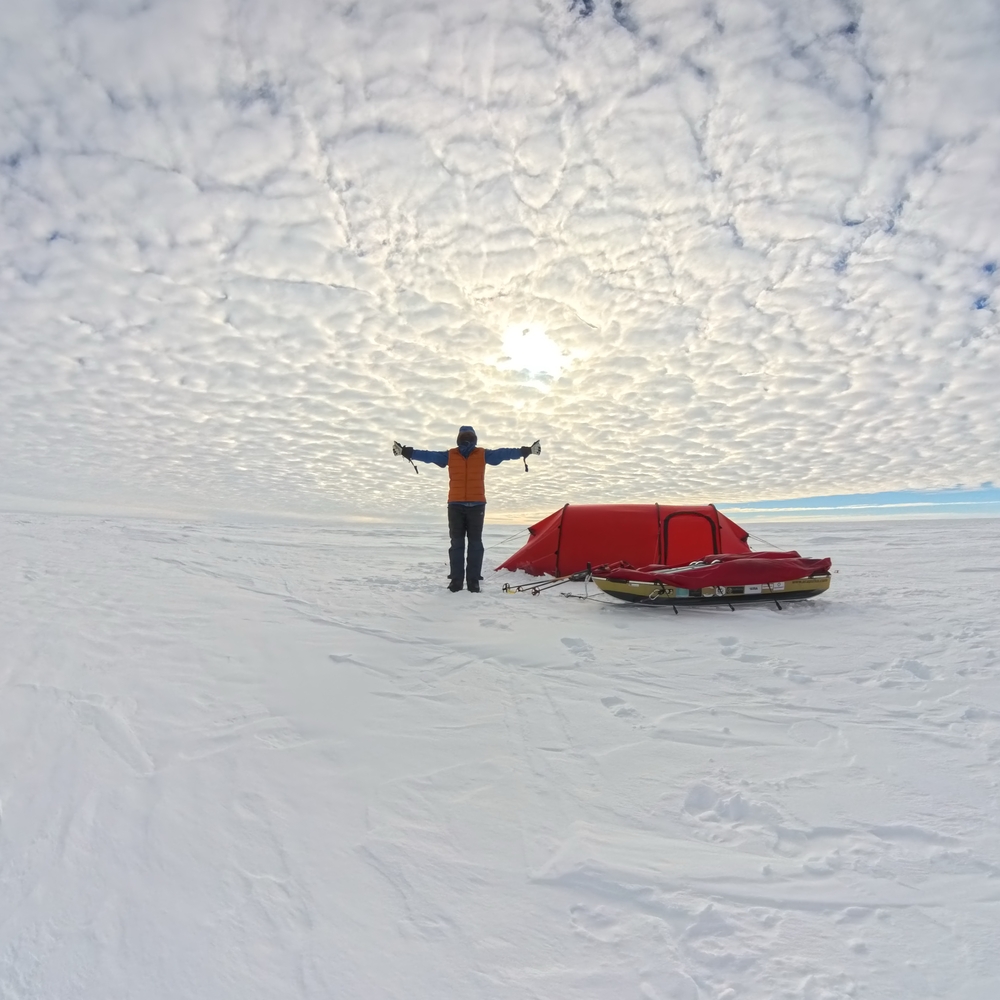
Marathons to Mountains: The Evolution of an Adventurer
An adventurer, Satish began his journey with marathons and ultramarathons and later transitioned to mountaineering. His love for adrenaline and representation took him to some of the most interesting parts of the world, where not many Indians had stepped in. He was the second Indian to scale Mt Aconcagua in 2022, the highest mountain in the Southern Hemisphere. “That mountain hasn’t been scaled solo after me.” Summitting Mt Aconcagua gave him the confidence to climb Mt Everest.
His love for adventure began when he moved to the US to pursue his master’s in electrical engineering at the University of Louisville. It was here that the Hyderabad-born and raised reconnected with his adventurous streak and soon saw himself in marathons and climbing mountains.
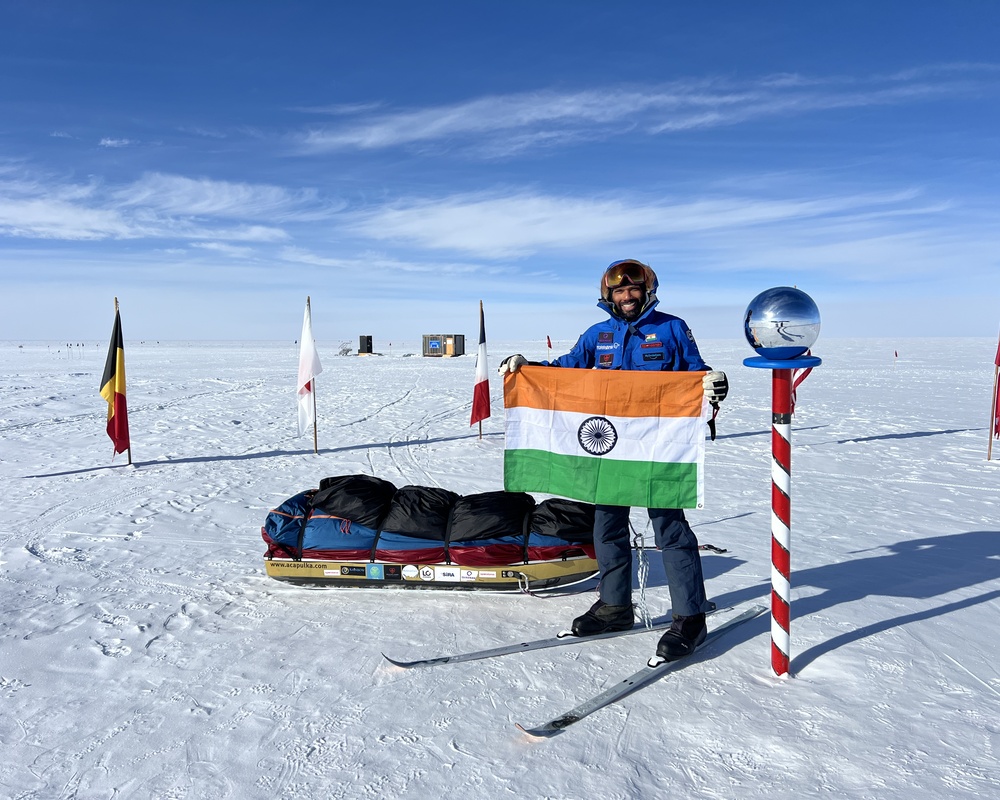
Satish Gogineni
Being Global Indian
Having lived in the San Francisco Bay Area for over a decade now, Satish is part a huge Indian community that is well-respected in that corner of the US. “In terms of technology, there’s no better place than San Francisco, and I feel at home here. But the moment I step into the outdoors, I feel we are not well represented in that space. That’s the stigma I’m working to change,” says Satish Gogineni, who has been living in the US for two decades now.
“I still get goosebumps carrying the Indian flag. I’m proud of the heritage and culture I represent. For me, being Global Indian means carrying its values.” — Satish Gogineni
What’s Next? Conquering the North Pole and Beyond
Now after completing the expedition to the South Pole, Satish Gogineni has his eyes on the North Pole expedition, something no one has attempted since 2015. “It comes with challenges since it can only be done in winter when temperatures drop to -50°C. The required skillset is different—you need to know how to swim and handle polar bears. Still, I’m keen on doing the North Pole last degree. It would be incredible to complete both the North and South Poles in the same year,” says the adventurer, who also aims to summit Mount Nuptse.
“It is one of the most challenging and technical peaks in the world. There are less than 30 people who have climbed Mt Nuptse, while each year around 300 people climb Mt Everest. I am trying to go to places that have never been done before by Indians and trying to change the mindset of people that I’m capable of doing this,” he concludes.

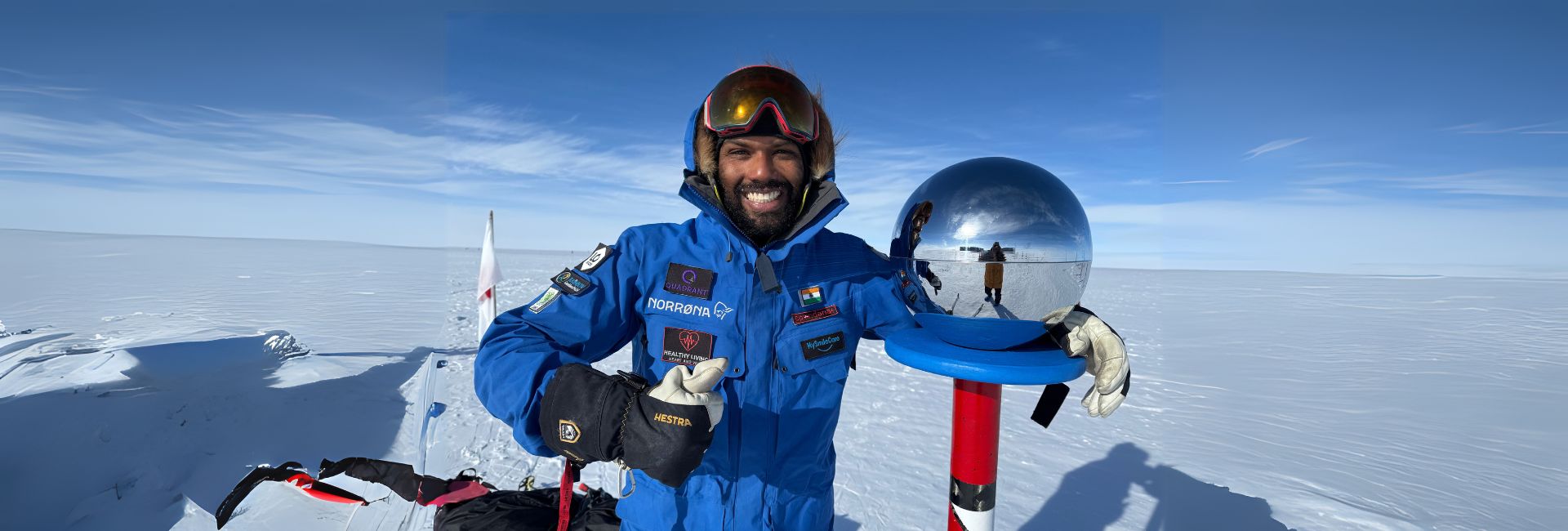



I have followed Satish’s Antarctic adventure with interest. Wonderful achievement.Even more so having done it to raise Mental Health awareness.
Best wishes for all your future adventures.
Great Satish !
Many congratulations, proud of you !